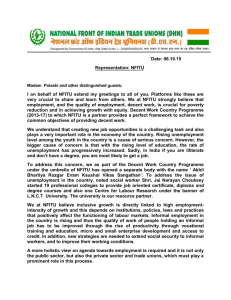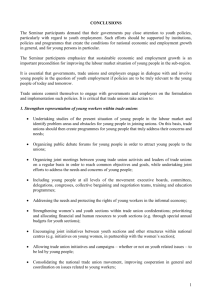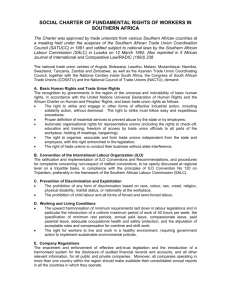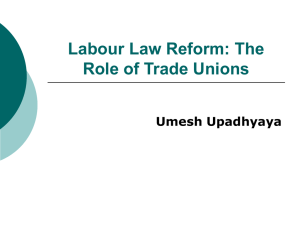Retrospect and Prospects - The Institute of Employment Rights
advertisement
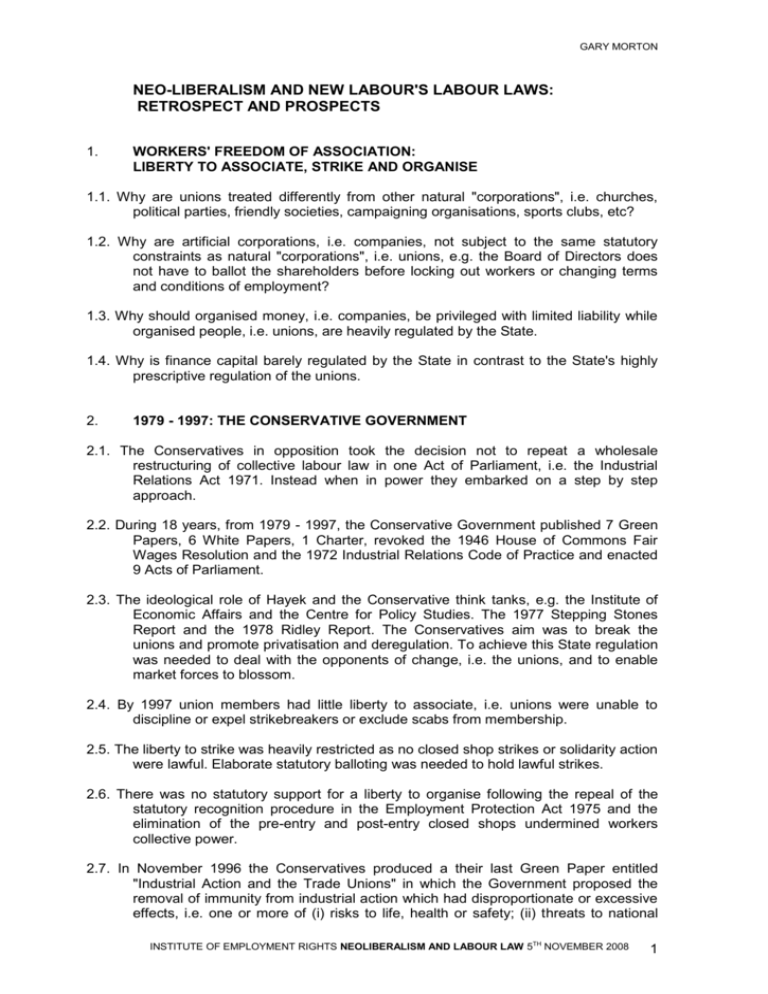
GARY MORTON NEO-LIBERALISM AND NEW LABOUR'S LABOUR LAWS: RETROSPECT AND PROSPECTS 1. WORKERS' FREEDOM OF ASSOCIATION: LIBERTY TO ASSOCIATE, STRIKE AND ORGANISE 1.1. Why are unions treated differently from other natural "corporations", i.e. churches, political parties, friendly societies, campaigning organisations, sports clubs, etc? 1.2. Why are artificial corporations, i.e. companies, not subject to the same statutory constraints as natural "corporations", i.e. unions, e.g. the Board of Directors does not have to ballot the shareholders before locking out workers or changing terms and conditions of employment? 1.3. Why should organised money, i.e. companies, be privileged with limited liability while organised people, i.e. unions, are heavily regulated by the State. 1.4. Why is finance capital barely regulated by the State in contrast to the State's highly prescriptive regulation of the unions. 2. 1979 - 1997: THE CONSERVATIVE GOVERNMENT 2.1. The Conservatives in opposition took the decision not to repeat a wholesale restructuring of collective labour law in one Act of Parliament, i.e. the Industrial Relations Act 1971. Instead when in power they embarked on a step by step approach. 2.2. During 18 years, from 1979 - 1997, the Conservative Government published 7 Green Papers, 6 White Papers, 1 Charter, revoked the 1946 House of Commons Fair Wages Resolution and the 1972 Industrial Relations Code of Practice and enacted 9 Acts of Parliament. 2.3. The ideological role of Hayek and the Conservative think tanks, e.g. the Institute of Economic Affairs and the Centre for Policy Studies. The 1977 Stepping Stones Report and the 1978 Ridley Report. The Conservatives aim was to break the unions and promote privatisation and deregulation. To achieve this State regulation was needed to deal with the opponents of change, i.e. the unions, and to enable market forces to blossom. 2.4. By 1997 union members had little liberty to associate, i.e. unions were unable to discipline or expel strikebreakers or exclude scabs from membership. 2.5. The liberty to strike was heavily restricted as no closed shop strikes or solidarity action were lawful. Elaborate statutory balloting was needed to hold lawful strikes. 2.6. There was no statutory support for a liberty to organise following the repeal of the statutory recognition procedure in the Employment Protection Act 1975 and the elimination of the pre-entry and post-entry closed shops undermined workers collective power. 2.7. In November 1996 the Conservatives produced a their last Green Paper entitled "Industrial Action and the Trade Unions" in which the Government proposed the removal of immunity from industrial action which had disproportionate or excessive effects, i.e. one or more of (i) risks to life, health or safety; (ii) threats to national INSTITUTE OF EMPLOYMENT RIGHTS NEOLIBERALISM AND LABOUR LAW 5TH NOVEMBER 2008 1 GARY MORTON security, (iii) serious damage to property or to the economy, (iv) significant disruption of everyday life or activities in the whole or part of the country (para. 2.5). The Green Paper also proposed raising the threshold for an industrial action ballot from a majority of those voting to a majority of those entitled to vote, i.e. abstentions being counted as votes against industrial action. 1979 - 1997: THE TUC's PROPOSALS 3.1. In 1986 the TUC published "Industrial Relations Legislation" which was critical of the statutory recognition procedure in the Employment Protection Act 1975. 3.2. From 1990 onwards (if not earlier) the TUC warmed to the concept of a policy of phased recognition leading to full recognition which crystallised in the 1995 TUC Congress document "Your Voice at Work." 3.3. Your Voice at Work 1995 proposed 3 broad new rights (i) a universal right to representation and the right of unions to organise and have access to the workplace and protection for individuals against victimisation (ii) consultation rights when 10% of the employees were union members, and (iii) collective bargaining rights if a majority in a ballot, or some other means of surveying opinion, wanted collective bargaining rights. The right of representation was confined to a recognised union if there was one. 3.4. By 1997 the TUC had implicitly accepted the Conservative Government's restrictions on (i) the liberty to associate and (ii) restrictions on the liberty to strike. In contrast the TUC was in favour of (iii) a limited liberty to organise and the restoration of union recognition at GCHQ. 4. 1979 - 1997: LABOUR IN OPPOSITION 4.1. Initially, Labour and the TUC was in favour of repealing all anti-union laws, i.e. a return to the status quo in 1979. In 1985 the TUC and Labour Party Liaison Committee said that when in power a Labour Government would repeal the Government's divisive legislation and replace it with positive legislation. 4.2. In 1991 the Labour Party proposed in "labour's better way for the 1990s" that (i) trade union rights would be restored at GCHQ (ii) the European Social Charter would be signed (iii) there would be a national minimum wage, and (iv) a flexible decade of retirement between 60 and 70. 4.3. At the October 1994 Labour Party conference Blair said that strike ballots were to be retained. In September 1995 Blair told the TUC that there was not going to be a repeal of all the Tory trade union laws. 4.4. In the June 1996 document "Building Prosperity - Flexibility, Efficiency and Fairness at Work" the Labour Party said that "The old approach of trade union immunities as the basis for legislation has gone. Indeed the Labour Party was moving away from it, even in the 1980s. There will be no blanket repeal of the main elements of the 1980s legislation ... social partnership is at the heart of the successful company of the future." The proposals were that (i) individuals should have the right to be accompanied at disciplinary or grievance procedure meetings (ii) employees would have a choice as to whether to join a union or not (iii) a majority vote would secure collective bargaining on pay, hours, holidays and training (iv) dismissed employees engaged in lawful industrial action could complain to employment tribunals, and (v) INSTITUTE OF EMPLOYMENT RIGHTS NEOLIBERALISM AND LABOUR LAW 5TH NOVEMBER 2008 2 GARY MORTON repeated authorisations from union members to confirm the check-off of union subscriptions would be ended. 5. 1997 - 2008: THE NEW LABOUR GOVERNMENT 5.1. In the foreword to the May 1998 "Fairness at Work" White Paper Blair said that "There will be no going back. The days of strikes without ballots, mass picketing, closed shops and secondary action are over. Even after the changes we propose, Britain will have the most lightly regulated labour market of any leading economy in the world." LIBERTY TO ASSOCIATE 5.2. The only cosmetic concession to the unions in the Employment Relations Act (ERA) 1999 was the abolition of the 2 Commissioners (CROTUM and CPUIA) and her replacement by the Certification Officer with strengthened quasi-judicial powers. 5.3. Following the case of Lee v. ASLEF (24 February 2004 UKEAT/0625/03) section 33 of the ERA 2004 was passed amending section 174 of the Trade Union and Labour Relations (Consolidation) Act 1992. The amendment drew a distinction between political party membership (protected conduct) and political party activities (not protected conduct). 5.4. The European Court of Human Rights in ASLEF v. United Kingdom [2007] IRLR 361 stated at paragraph 39 that Article 11 of the European Convention on Human Rights "... cannot be interpreted as imposing an obligation on associations or organisations to admit whosoever wishes to join." The ECHR went on to say that "By way of example, it is uncontroversial that religious bodies and political parties can generally regulate their membership to include only those who share their beliefs and ideals ... in the exercise of their rights under Article 11(1) unions must remain free to decide, in accordance with union rules, questions concerning admission to and expulsion from the union ...". The ECHR decided that ASLEF's Article 11 rights to freedom of association had been violated by the UK Government. 5.5. Despite the ECHR's decision that Article 11 of the European Convention on Human Rights "... cannot be interpreted as imposing an obligation on associations or organisations to admit whosoever wishes to join" the Government decided to ignore it. In a consultation document entitled "ECHR judgment in ASLEF v UK case implications for trade union law" it stated that "The Court did not give any opinion as regards other limitations under UK law on the ability of trade unions to expel, exclude or otherwise discipline their members. Nor do the general principles set out in the Court's judgment imply that there can be no justification under Article 11 for other limitations on the freedom of trade unions to determine their membership" (paragraph 4.2). 5.6. ASLEF succeeded in its argument that its Article 11 rights had been violated (paragraph 53). The Government failed in its argument that "... the special status of trade unions ... set them apart from other voluntary associations ... they play a potentially very important role in the working lives of individuals ... exercising a direct influence over matters such as pay, holidays and other terms and conditions of employment ..." (paragraph 34). 5.7. Clause 19 of the Employment Bill 2008 amends section 174 of TULR(C)A 1992 to deal with membership of a political party where it is contrary to a rule or objective of a INSTITUTE OF EMPLOYMENT RIGHTS NEOLIBERALISM AND LABOUR LAW 5TH NOVEMBER 2008 3 GARY MORTON union. Unions will still be unable to discipline or expel strikebreakers or exclude scabs. LIBERTY TO STRIKE 5.8. In Blackpool and the Fylde College v. NATFHE [1994] ICR 648, the Court of Appeal decided that when a union balloted their members over industrial action (sections 226A and 234A of TULR(C)A 1992) the union had to specify a category or name individuals or by a combination of the two enable the employer to readily ascertain which employees were being balloted. 5.9. The ERA 1999 in schedule 3 amended sections 226A and 234A by removing "describing (so that he can readily ascertain them) the employees of the employer" and replaced it with "containing such information in the union's possession as would help the employer to make plans and bring information to the attention of those of his employees." If the union possessed the information then it was to provide details as to the number, category or wok-place of the employees concerned. 5.10. The ERA 1999 amendments to sections 226A and 234A were considered in National Union of Rail, Maritime and Transport Workers v. London Underground Ltd [2001] IRLR 228, where the Court of Appeal remarked that the ERA 1999 changes were not intended to make the preparation of balloting notices easier and indeed it might make the task more onerous because a union was not bound to provide a list of names (paragraph 46). 5.11. As an alternative to seeking an injunction to prevent unlawful industrial action an employer can seek damages for damage caused by unlawful industrial action. In Willerby Homes v. UCATT [2003] EWHC 2608, QBD, UCATT had to pay £130,458 in damages plus costs for losses incurred in a two week strike because it had given the employer erroneous information about the members to be balloted and lost its protection under section 226A. 5.12. The ERA 2004 again amended 226A and 234A to introduce a requirement on unions to produce two lists (a) a list of categories of employees and (b) a list of the employees workplaces (alternatively, or in addition to checkoff lists). This is to enable employers to readily deduce (a) the total number of employees concerned (b) the number of employees in each of those categories, and (c) the number of employees at each workplace. 5.13. The Texas Pacific Group Gate Gourmet (GG) dispute illuminates the potential consequences flowing from unlawful industrial action. On 10 August 2005 GG workers attended a mass meeting in the works canteen. They were given 3 minutes to get back to work or be sacked. An unlawful solidarity strike by British Airways (BA) ground staff cost BA £40m. GG replaced the sacked GG workers with agency workers from Versa Logistics a wholly owned subsidiary of GG. On 21 August 2005 the High Court granted an injunction restraining the T&G from picketing away from site B (500 metres from GG's premises) and limiting pickets to 6 at site A opposite GG's premises. On 22 August GG threatened to put the company into administration unless BA paid GG more for its in-flight meals. On 24 August GG lifted its threat following an agreement with BA over the terms of an improved supply contract. On 26 August GG and the T&G reached an agreement to settle the dispute. On 14 December the Financial Times reported that 100 ex-employees of GG had failed in their claims of unfair dismissal as an employment tribunal had decided that their strike was "illegal." On 28 February 2006 Personnel Today reported that GG had re-engaged 252 out of 800 sacked staff. The similarities with INSTITUTE OF EMPLOYMENT RIGHTS NEOLIBERALISM AND LABOUR LAW 5TH NOVEMBER 2008 4 GARY MORTON Murdoch's dismissal of 5,000 printworkers at Wapping in January 1986 are obvious. LIBERTY TO ORGANISE 5.14. The proposed right to accompaniment in "Fairness at Work" alarmed the Financial Times which in an editorial dated 22 May 1998 said that "... any union member ... will have the right to union representation during grievance or disciplinary procedures. That last ... provides the unions with a toe-hold in any company in the land, and the CBI is right ... that ... it should only apply to disciplinary matters, not run of the mill grievances. It could prove a powerful recruiting sergeant for the unions ...". Barrie Clements in the Independent on 11 July 1998 confirmed that the CBI were concerned that where unions were not recognised they could prevail on their members to register grievances on pay which, with sufficient numbers, could become a collective wage claim. 5.15. The ERA 1999 was enacted on 27 July. During the passage of the Bill the right to representation was whittled down by defining a grievance as a duty owed by an employer to a worker, e.g. a statutorily implied equal pay clause in a worker's contract (Section 13(6)). 5.16. The Section 10 ERA 1999 right is to accompaniment by an employed union official, or a certified official employed by that employer, i.e. a worker's companion can be an employee of an unrecognised union. The right came into force on 4 September 2000. Compensation for a breach of this right is up to 2 weeks wages currently capped at £330 a week. This is a union right which is not dependent on an employer recognising a union. 5.17. The Flexible Working (Procedural Requirements) Regulations 2002 came into force on 6 April 2003. The right to be accompanied is confined to a fellow worker. Similarly, in schedule 6, paragraph 9(2)(b), of the Employment Equality (Age) Regulations 2006 which came into force on 1 October 2006. 5.18. The ERA 1999 brought in the third attempt at statutory recognition. The current version has more in common with the IRA 1971 than the EPA 1975 and like statutory recognition in the United States incorporates employer free speech rights, i.e the ability of employers and their agents, e.g. the Burke Group, to campaign against union recognition. Legitimate campaigning activity includes threatening to shut the company if the workers vote in favour, i.e. (i) Amicus and GE Thermometrics (UK) Ltd (TUR 1/347/04) and (ii) BECTU and Sky Subscriber Services Ltd (TUR 1/222/02). Unsurprisingly in both cases the unions failed to obtain recognition. 5.19. The procedure gives employers the right to choose the workers' union. The level of support for the workers' choice is irrelevant if the employer has helped to create and recognise a dependent "union", i.e. Prison Officers' Association and Securicor Custodial Services Ltd (TUR1/5/00) and the News International Staff Association. Alternatively, an employer can recognise an unrepresentative independent union with no or very few members in that company, i.e. Bausch and Lomb (Award plc) (TUR 1/8/00) where the company had an agreement with the AEEU and consequentially the Central Arbitration Committee did not accept the ISTC's application. In National Union of Journalists and Sports Division Mirror Group Newspapers Ltd (TUR 1/307/03) the NUJ's application for recognition was rejected as the company recognised the British Association of Journalists who had one member. The CAC found that over half the journalists were in the NUJ. The NUJ's appeals to the High Court and Court of Appeal were rejected. INSTITUTE OF EMPLOYMENT RIGHTS NEOLIBERALISM AND LABOUR LAW 5TH NOVEMBER 2008 5 GARY MORTON 5.20. If the CAC declares that a union is recognised then the employer has to engage in a dialogue with the union through a bargaining procedure. The employer is not obliged to agree to changes to terms and conditions of employment, i.e. pay, hours or holidays. There is no recourse to arbitration, e.g. schedule 11 of the EPA 1975. Even with a legally enforceable contract the obligation on the employer to negotiate is purely procedural. The employer's ability to negotiate different terms with individuals is safeguarded by paragraph 18 of the Trade Union Recognition (Method of Collective Bargaining) Order 2000. 5.21. The Government published a consultation paper entitled a "Review of the ERA 1999" in February 2003. The Government proposed (i) that after the CAC had decided that a union's application was admissible and prior to a ballot the union could distribute written material via a qualified independent person. No similar restrictions were placed on employers who could communicate directly with their employees; (ii) Pensions were not to be regarded as pay reversing Union Bank of Nigeria v. Unifi [2001] IRLR 712 (TUR 1/16/00); (iii) section 146(3) of TULR(C)A 1992 (the Ullswater amendment) should be repealed and the law amended to "... to specify that the entering of individualised contracts would not constitute unlawful union discrimination against those union members not offered them, provided there is no pre-condition in the contracts to relinquish union representation...". There was protection for the bare right to be a union member but nothing more, i.e. no protection for union negotiated collective agreements. 5.22. The Review then dealt with the judgment of the ECHR in Wilson and NUJ v. UK and Palmer and Others and NURMTTW v. UK [2002] IRLR 568. The ECHR at paragraph 42 said that "A trade union must thus be free to strive for the protection of its members' interests, and the individual members have a right, in order to protect their interests, that the trade union should be heard ...". At paragraph 46 the Court continued "Furthermore, it is of the essence of the right to join a trade union for the protection of their interests that employees should be free to instruct or permit the union to make representations to their employer or to take action in support of their interests on their behalf. If workers are prevented from so doing, their freedom to belong to a trade union, for the protection of their interests, becomes illusory. It is the role of the State to ensure that trade unions members are not prevented or restrained from using their union to represent them in attempts to regulate their relations with their employers." 5.23. The Government's response to this judgment was to ignore it. They said (page 65, paragraph 3.17) that "The judgment refers to the right for the union "to be heard", which the Court views as inherent to Article 11 ... However, the Court has never expressed any view on what the right implies as a minimum. It has certainly never stated that the right to be heard requires the employer to respond to the points a union might make ... Under current UK law, unions can exercise their right to be heard by a number of means, including the freedom to be recognised or seek recognition ... and generally to make representations to the employer. These and other arrangements guarantee the right to be heard implied by Article 11." 5.24. The Employment Act 2002 (Dispute Resolution) Regulations 2004 came into force on 1 October 2004. Regulation 9 contains a provision confining the raising of collective grievances to independent recognised unions and recognised employee representatives, i.e. excluding independent unrecognised unions. The section 10 ERA 1999 right of the unrecognised union to accompany an individual was not extended to a collective right to accompaniment in the regulations implementing the 2002 statutory procedures which are due for repeal by April 2009. INSTITUTE OF EMPLOYMENT RIGHTS NEOLIBERALISM AND LABOUR LAW 5TH NOVEMBER 2008 6 GARY MORTON 5.25. The Information and Consultation of Employees Regulations 2004 came into force on 6 April 2005. The ability of employers to avoid directly consulting with employee representatives is safeguarded under regulation 16(1)(f)(ii) which states that a negotiated agreement can provide that the employer communicates information directly and consults directly with employees. The employer is responsible for electing or appointing the representatives who are to negotiate with the employer over the terms of the information and consultation agreement. 6. THE UNIONS IN 2008 6.1. Trade union membership has dramatically declined since 1979. In 1980 the Certification Officer (CO) said that here were 13,212,354 union members. In 1998 the CO said that the 1997 figure was 7,938,213. The CO report for 2006-7 gives a figure of 7,602,842. Over the New Labour decade overall trade union membership has stagnated in contrast to the growth of union membership between 1975-9. 6.2. The Labour Force Survey figures show 6,911,000 union members in 1997 and 6,677,000 in 2005. The density of union membership in Autumn 1997 was 27.5% and 26.2% in Autumn 2005. In Autumn 2005 less than one in five (17.5%) private sector employees were union members but almost three in five (58.6%) public sector employees were union members. 6.3. The marked difference in the density of private and public sector trade union membership is partly attributable to the fact that union recognition is the norm in the public sector. In contrast in much of the private sector the unions have no legitimacy. 7. 2008 AND THE NEAR FUTURE 7.1. There is a common theme linking the statutory restrictions on the liberty to associate, strike and organise, i.e. that unions are illegitimate and that non-union employees, employers and the public need to be protected from trade unionism. Private sector employers have a veto on voluntary union recognition and with a declaration of statutory recognition they only have to go through a negotiating procedure. 7.2. In general there appears to be tripartisan party political support for the status quo. The TUC appear to be broadly satisfied with current collective labour law and show no appetite for change. 7.3. Between now and the next General Election the only opportunities for changing statute law are the current Employment Bill or the forthcoming Equality Bill. Radical positive change seems extremely unlikely as the priority of the Labour Party affiliated unions will be the re-election of a Labour Government. 7.4. Over the next 18 months to 2 years or more the impact of the economic recession on employment levels and trade union membership is likely to be negative. 7.5. In the next couple of years there is the possibility of a change of Government which raises the question of what changes the Conservatives might make to collective labour law. At the moment there is little indication that collective labour law reform is a Conservative priority. Given New Labour's adherence to neo-liberalism the Conservatives may take the view that statutory recognition is compatible with neoliberalism and consider that the current statutory recognition regime is similar to the first statutory recognition procedure brought in by the Conservatives under the Industrial Relations Act 1971, i.e. that the objectives of the IRA 1971 have been achieved. INSTITUTE OF EMPLOYMENT RIGHTS NEOLIBERALISM AND LABOUR LAW 5TH NOVEMBER 2008 7 GARY MORTON 8. IS THERE AN ALTERNATIVE? 8.1. This is not 1824-5, 1871-5, 1906 or 1974. All the major parties support the status quo as does the TUC and through membership of the TUC the TUC affiliated unions. The unions affiliated to the Labour Party also give financial support to New Labour's neo-liberal policies. There is currently no movement, party or organisation proposing a liberty for workers to associate, strike and organise. However, some simple principles can be suggested by way of a radical alternative to the status quo. 8.2. Following the ECHR decision in ASLEF v. UK on liberty of association unions should have the freedom to decide who can join a union and the circumstances under which individuals can be disciplined, expelled or excluded from membership. 8.3. Following the ECHR decision in Wilson and NUJ v. UK on liberty to organise workers should be able to join and be collectively represented by a union of their choice. 8.4. The liberty to organise has been bedeviled by the problem that prior to Wilson & Palmer in the ECHR it had been an individual and not a collective right. The "right" to strike has been bedeviled by Lumley v. Gye ([1853] 118 Eng. Rep. 749, QBD) liability where the union in tort is placed in the position of inducing another person to break a contract, etc, (section 219(1) of TULR(C)A 1992). The separation of the individual from the collective establishes the triangular relationship necessary for Lumley v. Gye liability and the bilateral employer/employee relationship is the foundation of the breach of contract which is an unlawful act. 8.5. There is no similar distinction between a company (the collective) and a shareholder (the individual). The artificial corporation has a single legal personality and can engage in industrial action, i.e. a lockout, like Gate Gourmet, without the need to comply with any statutory obligations, unlike trade unions, i.e. sections 219-246 of TULR(C)A 1992. 8.6. To gain the liberty to strike there will need to be the suspension of the (individual) employment contract during (collective) strike action and the removal of Lumley v. Gye liability so that the liberty to strike is an individual right which is exercised collectively. Lord Nicholls in OBG Ltd v. Allan [2007] IRLR 608, HL, said that in Lumley v. Gye cases "... the defendant is responsible for the third party's breach of contract which he procured. In that circumstance this tort provides a claimant with an additional cause of action. The third party who breached his contract is liable for breach of contract. The person who persuaded him to break his contract is also liable, in his case in tort." He described the tort as a form of "accessory liability" as it is secondary to the third party who commits a breach of his contract (paragraph 171). 8.7. There are practical problems in trying to articulate alternatives to the status quo. There is no easy way forward but if the trade union movement continues to support, and in some cases bankroll the Government's neo-liberal policies, it will be impossible to regain at least the autonomy that the trade unions enjoyed in 1979. 31 October 2008. Gary Morton. 7 New Square Chambers, Lincoln's Inn, London WC2A 3QS. INSTITUTE OF EMPLOYMENT RIGHTS NEOLIBERALISM AND LABOUR LAW 5TH NOVEMBER 2008 8


